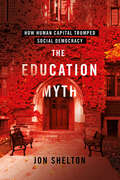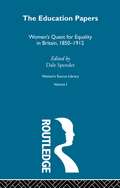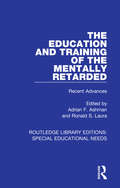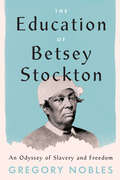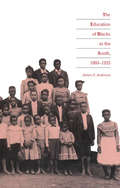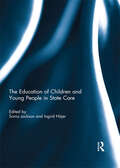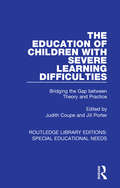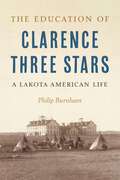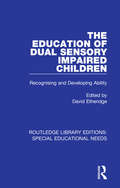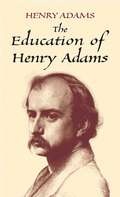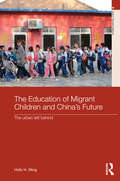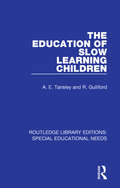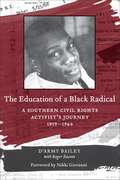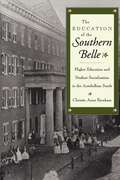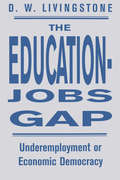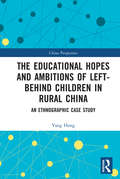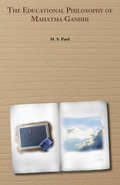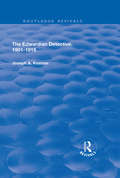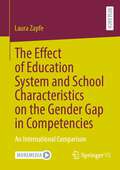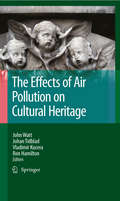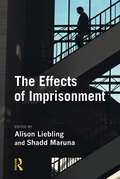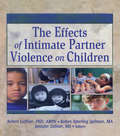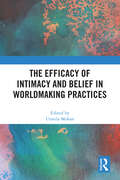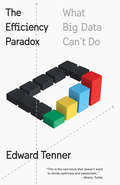- Table View
- List View
The Education Myth: How Human Capital Trumped Social Democracy (Histories of American Education)
by Jon SheltonThe Education Myth questions the idea that education represents the best, if not the only, way for Americans to access economic opportunity. As Jon Shelton shows, linking education to economic well-being was not politically inevitable. In the eighteenth and nineteenth centuries, for instance, public education was championed as a way to help citizens learn how to participate in a democracy. By the 1930s, public education, along with union rights and social security, formed an important component of a broad-based fight for social democracy.Shelton demonstrates that beginning in the 1960s, the political power of the education myth choked off powerful social democratic alternatives like A. Philip Randolph and Bayard Rustin's Freedom Budget. The nation's political center was bereft of any realistic ideas to guarantee economic security and social dignity for the majority of Americans, particularly those without college degrees. Embraced first by Democrats like Lyndon Johnson, Jimmy Carter, and Bill Clinton, Republicans like George W. Bush also pushed the education myth. The result, over the past four decades, has been the emergence of a deeply inequitable economy and a drastically divided political system.
The Education Papers (Women's Source Library #Vol. 1)
by Dale SpenderFirst published in 1987, this volume makes available key documents, giving the contemporary reader a valuble record of women's struggle for eduacation in the nineteenth and early twentieth centuries. All of the women in this collection achieved significant reforms or struggled to change popular prejudices about women's education
The Education and Training of the Mentally Retarded: Recent Advances (Routledge Library Editions: Special Educational Needs #1)
by Adrian F. Ashman, Ronald S. LauraFirst published in 1985. The field of mental handicap is a broad one encompassing the interests of many professional groups. As a result, there is a need periodically to present wide-ranging reviews of advances in the field. This is the central aim of this volume. Two chapters focus on the cognitive domain, and are especially pertinent in view of the recent release of the new Kaufman Assessment Battery for Children which uses Das’s theoretical position as its foundation. Another contribution reviews the area of non-speech communication with those with special needs, a subject of much current interest and controversy. Other chapters focus on major issues such as maladaptive behaviour and deinstitionalization and use of new technology. The book is thus likely to be relevant to all those with an interest in advances in mental handicap research.
The Education of Betsey Stockton: An Odyssey of Slavery and Freedom
by Gregory NoblesA perceptive and inspiring biography of an extraordinary woman born into slavery who, through grit and determination, became a historic social and educational leader. The life of Betsey Stockton (ca. 1798–1865) is a remarkable story of a Black woman’s journey from slavery to emancipation, from antebellum New Jersey to the Hawai‘ian Islands, and from her own self-education to a lifetime of teaching others—all told against the backdrop of the early United States’ pervasive racism. It’s a compelling chronicle of a critical time in American history and a testament to the courage and commitment of a woman whose persistence grew into a potent form of resistance. When Betsey Stockton was a child, she was “given, as a slave” to the household of Rev. Ashbel Green, a prominent pastor and later the president of what is now Princeton University. Although she never went to school, she devoured the books in Green’s library. After being emancipated, she used that education to benefit other people of color, first in Hawai‘i as a missionary, then Philadelphia, and, for the last three decades of her life, Princeton—a college town with a genteel veneer that never fully hid its racial hostility. Betsey Stockton became a revered figure in Princeton’s sizeable Black population, a founder of religious and educational institutions, and a leader engaged in the day-to-day business of building communities. In this first book-length telling of Betsey Stockton’s story, Gregory Nobles illuminates both a woman and her world, following her around the globe, and showing how a determined individual could challenge her society’s racial obstacles from the ground up. It’s at once a revealing lesson on the struggles of Stockton’s times and a fresh inspiration for our own.
The Education of Blacks in the South, 1860-1935
by James D. Andersoninterpretation of "the history of southern black education from Reconstruction to the Great Depression.
The Education of Blacks in the South, 1860-1935
by James D. AndersonJames Anderson critically reinterprets the history of southern black education from Reconstruction to the Great Depression. By placing black schooling within a political, cultural, and economic context, he offers fresh insights into black commitment to education, the peculiar significance of Tuskegee Institute, and the conflicting goals of various philanthropic groups, among other matters. Initially, ex-slaves attempted to create an educational system that would support and extend their emancipation, but their children were pushed into a system of industrial education that presupposed black political and economic subordination. This conception of education and social order--supported by northern industrial philanthropists, some black educators, and most southern school officials--conflicted with the aspirations of ex-slaves and their descendants, resulting at the turn of the century in a bitter national debate over the purposes of black education. Because blacks lacked economic and political power, white elites were able to control the structure and content of black elementary, secondary, normal, and college education during the first third of the twentieth century. Nonetheless, blacks persisted in their struggle to develop an educational system in accordance with their own needs and desires.
The Education of Children and Young People in State Care
by Sonia Jackson and Ingrid HöjerYoung people who leave care with few or no educational qualifications are at very high risk of social exclusion in adulthood. Yet in the past their education has attracted little attention from researchers or professionals. Studies by the editors and contributors to this volume show that the educational standards attained by young people in care fall progressively behind those of their peers living with their own families. This research-based book looks at the educational experiences of children and youths in nine different European countries and Canada. It identifies the obstacles that prevent them from realising their aspirations and discusses ways of improving their opportunities. How can countries with different traditions, welfare regimes and administrative systems learn from each other? What needs to be done at national, local and individual levels to give children in care equal chances with those living with their families? At present a child in public care is five times less likely to go to university than others. How can teachers, social workers and carers better support their educational attainment, and enable more of them to succeed and progress to tertiary education? This book was originally published as a special issue of the European Journal of Social Work.
The Education of Children with Severe Learning Difficulties: Bridging the Gap between Theory and Practice (Routledge Library Editions: Special Educational Needs #11)
by Judith Coupe and Jill PorterFirst published in 1986. Aimed at teachers, students and related professions this book serves to bridge the gap between the theory and practice of educating pupils with severe learning difficulties. In the light of the 1981 Education Act it is crucial to identify, and subsequently meet, the needs of these pupils. This can only be done by an in-depth understanding of curriculum design, child development and the learning process. This book incorporates these aspects together with an appreciation of teaching techniques and school and classroom organisation. It explains how the parents, school staff and linked agencies complement this procedure.
The Education of Clarence Three Stars: A Lakota American Life
by Philip BurnhamIn The Education of Clarence Three Stars Philip Burnham tells the life story of the remarkable Packs the Dog, a member of the Minneconjou Lakotas who was born in 1864 east of the Black Hills. His father, Yellow Knife, died when the boy was five, and the family eventually enrolled at Pine Ridge Agency with the Oglalas under an uncle&’s name, Three Stars. In 1879 Packs the Dog joined the first class of Indian students to be admitted to the Carlisle Indian Industrial School. An enthusiastic student, Clarence Three Stars, as he would come to be known, was one of five Lakota children who volunteered to stay at Carlisle after the three-year plan of instruction was finished—though he eventually left the school in frustration. Three Stars returned to Pine Ridge and married Jennie Dubray, another Carlisle veteran, and they had seven children. The life of Lakota advocate Three Stars spanned a time of dramatic change for Native Americans, from the pre-reservation period through the Dawes Act of 1887 until just before the Indian Reorganization Act of 1934. Three Stars was a teacher, interpreter, catechist, lawyer, and politician who lived through the federal policy of American Indian assimilation in its many guises, including boarding school education, religious conversion, land allotment, and political reorganization. He used the fundamentals of his own boarding school education to advance the welfare of the Oglala Lakota people, even when his efforts were deemed threatening or subversive. His dedication to justice, learning, and self-governance informed a distinguished career of classroom excellence and political advocacy on his home reservation of Pine Ridge.
The Education of Dual Sensory Impaired Children: Recognising and Developing Ability (Routledge Library Editions: Special Educational Needs #17)
by David EtheridgeThis book, originally published in 1995, is about ability, not disability. It is about what children can do and how they can progress. All children have the moral, ethical and legal right to be educated, no matter what barriers society puts in their way because of their physical disabilities. Dual sensory impaired children, like all others, have the right under the Education Reform Act, 1988, to a broadly-based and balanced curriculum that is appropriate to their needs since they, like any children, will not develop educationally unless that curriculum is appropriate to their needs. This book aims to show some of the ways in which individual children can demonstrate and develop their individual abilities.
The Education of Henry Adams
by Henry AdamsA scion of the famous Adams family of American statesmen, historian Henry Adams crafted this well-known autobiographical work, which reflects his constant search for order in a world of chaos. He cast himself as a modern everyman, seeking coherence in a fragmented universe and concluding that his education was inadequate for the demands of modern society.<P><P> Pulitzer Prize Winner
The Education of Migrant Children and China's Future: The Urban Left Behind (Routledge Studies in Asia's Transformations)
by Holly H. MingThere are more than 225 million rural-to-urban migrant workers, and some 20 million migrant children in Chinese cities. Because of policies related to the household registration (hukou) system, migrant students are not allowed a public high school education in the cities, so their urban education stops abruptly at the end of middle school. This book investigates the post-middle school education and labor market decisions of migrant students in Beijing and Shanghai, and provides a glimpse into the future of a crucial link in China’s development. The stories of how these migrant students seek upward mobility and urban citizenship also reveal one of the most intricate structural inequalities in China today. Based on quantitative data collected from middle schools in Beijing and Shanghai, and ethnographic data drawing on in-depth interviews with migrant children, their parents, and teachers, this book offers a portrait of the migration and educational experiences and prospects of second generation migrant youth in China today. It explores the urban experience of migrant students, contrasting it with that of local city youngsters, examining the migrant students’ family backgrounds, family dynamics, neighborhood and school experience, and interaction with locals. It goes on to look at the migrant students’ education and career aspirations, the structural obstacles preventing their fulfilment, and how migrant families respond to institutional constraints on educational opportunity. Finally, the book concludes with a discussion of policy implications and offers proposals for resolving the dilemmas of migrant youth. This book will of great interest to students and scholars of Chinese studies, Asian education, migration and social development.
The Education of Slow Learning Children (Routledge Library Editions: Special Educational Needs #53)
by A. E. Tansley R. GullifordOriginally published in 1960. The authors of this text examine ways in which both ordinary schools and special needs schools can further develop suitable education for pupils with special needs, including improved post-school guidance. This title aims to provide a guide to teachers in deciding the aims of their teaching and to assist in the planning of their teaching methods.
The Education of a Black Radical: A Southern Civil Rights Activist's Journey, 1959-1964
by Nikki Giovanni D’Army Bailey"A strong, uncompromising voice that dreams of a better America, Judge Bailey has experienced the ugliness of both racism and fear. Yet he has not stepped back. What a wonderful life to share." -- Nikki Giovanni, from her ForewordWhen four black college students refused to leave the whites-only lunch counter of a Greensboro, North Carolina, Woolworth's on February 1, 1960, they set off a wave of similar protests among black college students across the South. Memphis native D'Army Bailey, the freshman class president at Southern University -- the largest predominantly black college in the nation -- soon joined with his classmates in their own battle against segregation in Baton Rouge, Louisiana. In The Education of a Black Radical, Bailey details his experiences on the front lines of the black student movement of the early 1960s, providing a rare firsthand account of the early days of America's civil rights struggle and a shining example of one man's struggle to uphold the courageous principles of liberty, justice, and equality.A natural leader, Bailey delivered fiery speeches at civil rights rallies, railed against school officials' capitulation to segregation, joined a sit-in at the Greyhound bus station, and picketed against discriminatory hiring practices at numerous Baton Rouge businesses. On December 15, 1961, he marched at the head of two thousand Southern University students seven miles from campus to downtown Baton Rouge to support fellow students jailed for picketing. Baton Rouge police dispersed the peaceful crowd with dogs and tear gas and arrested many participants. After Bailey led a class boycott to protest the administration's efforts to quell the lingering unrest on campus, Southern University summarily expelled him.After his ejection, Bailey continued his academic journey north to Clark University in Worcester, Massachusetts, where liberal white students had established a scholarship for civil rights activists. Bailey sustained and expanded his activism in the North, and he provides invaluable eyewitness accounts of many major events from the civil rights era, including the protests in Washington D.C.'s financial district during the summer of 1963 and the gripping violence and arrests in Baltimore later that year. He sheds new light on the 1963 March on Washington by exploring the political forces that seized the march and changed its direction.Labeled "subversive" and a "black nationalist militant" by the FBI, Bailey crossed paths with many visionary activists. In riveting detail, Bailey recalls several days he spent hosting Malcolm X as a guest speaker at Clark, hanging out with Abbie Hoffman in the early days of the Worsester Student Movement, and personal interactions with other civil rights icons, including the Reverend Will D. Campbell, Anne Braden, James Meredith, Tom Hayden, and future congressmen Barney Frank, John Lewis, and Allard Lowenstein. D'Army Bailey gives voice to a generation of student foot soldiers in the civil rights movement. Moving, powerful, and intensely personal, The Education of a Black Radical offers an inspirational tale of hope and a courageous stand for social change. Moreover, it introduces an invigorating role model for a new generation of activists taking up the racial challenges of the twenty-first century.
The Education of the Southern Belle: Higher Education and Student Socialization in the Antebellum South
by Christie Anne FarnhamThe American South before the Civil War was the site of an unprecedented social experiment in women's education. The South offered women an education explicitly designed to be equivalent to that of men, while maintaining and nurturing the gender conventions epitomized by the ideal of the Southern belle. This groundbreaking work provides us with an intimate picture of the entire social experience of antebellum women's colleges and seminaries in the South, analyzing the impact of these colleges upon the cultural construction of femininity among white Southern women, and their legacy for higher education. Christie Farnham investigates the contradiction involved in using a male-defined curricula to educate females, and explores how educators denied these incongruities. She also examines the impact of slavery on faculty and students. The emotional life of students is revealed through correspondence, journals, and scrapbooks, highlighting the role of sororities and romantic friendships among female pupils. Farnham ends with an analysis of how the end of the Civil War resulted in a failure to keep up with the advances that had been achieved in women's education. The most comprehensive history of this brief and unique period of reform to date, The Education of the Southern Belle is must reading for anyone interested in women's studies, Southern history, the history of American education, and female friendship.
The Education-Jobs Gap: Underemployment Or Economic Democracy?
by D W LivingstoneAccording to Ivar Berg's performance criteria, over half of the U.S. workforce is now underemployed. Using analysis based on U.S. and Canadian surveys of work and learning experiences and other documental data, author David Livingstone exposes the myth of the "learning enterprise" and argues that the major problem in education-work relations is not education but the mismatch between work and worker.
The Educational Hopes and Ambitions of Left-Behind Children in Rural China: An Ethnographic Case Study (China Perspectives)
by Yang HongThis monograph highlights the educational experiences of rural children who are 'left behind' by their migrant worker parents in China, analyzing how this situation impacts on their aspirations and self-identity. Via an ethnographic and qualitative case study of a rural school in southwest China, the author presents the real lives of these disadvantaged children along with their challenges and needs, and provides an in depth understanding of how being ‘left behind’ impacts on their future aspirations. Building on the sociological theories of Pierre Bourdieu, the author makes an original contribution by combining seemingly incompatible disciplinary perspectives, such as cultural capital from sociology, rational action from behavioral economics, and self-efficacy from psychology. Hence, the book endeavors to transfer these Western theories to an Eastern context and demonstrates cultural nuances that are not always captured when applied in the West. The book will attract academic scholars and postgraduate students in the area of socially disadvantaged children and young people as well as those who are working on youth studies and rural education.
The Educational Philosophy of Mahatma Gandhi
by M. S. Patel“By education, I mean an all-round drawing out of the best in child and man—body, mind and spirit. Literacy is not the end of education nor even the beginning. It is one of the means whereby man and woman can be educated. Literacy in itself is no education.” … “the aim of education should be to develop to the full the potentialities of every child at school, in accord always with the general good of the community of which he is a member.” M. K. Gandhi
The Edwardian Detective: 1901-15 (Routledge Revivals)
by Professor Joseph KestnerThis title was first published in 1999 & examines the range of detective literature produced between 1901 and 1915 in Britain, during the reign of Edward VII and the early reign of George V. The book assesses the literature as cultural history, with a focus on issues such as legal reform, marital reform, surveillance, Germanophobia, masculinity/femininity, the "best-seller", the arms race, international diplomacy and the concept of "popular" literature. The work also addresses specific issues related to the relationship of law to literature, such as: the law in literature; the law as literature, the role of literature in surveillance and policing; the interpretation of legal issues by literature; the degree to which literature describes and interprets law; the description of legal processes in detective literature; and the connections between detective literature and cultural practices and transitions.
The Effect of Education System and School Characteristics on the Gender Gap in Competencies: An International Comparison
by Laura ZapfeLaura Zapfe’s aim is to explain how education system and school characteristics affect the gender gap in mathematics and reading competencies. She adapts the macro-meso-micro model. At the micro level, she uses theories, e.g., gender-specific socialization, highlighting how gender-specific expectations and stereotypes cause gendered interest and skills and therefore gender differences in mathematics and reading. Deriving a macro-meso-micro link, she explains how education system characteristics such as competition, differentiation, and standardization, and school characteristics could increase or decrease the gender-specific socialization effects, leading to larger or smaller gender gaps in mathematics and reading competencies. On this basis, she performs a cross-national comparison of 78 countries participating in the Programme for International Student Assessment (PISA) 2018, combined with further researched macro data with three-level mixed-effects models. The results show that boys have an advantage in mathematics, girls have an advantage in reading, the gender effects are slightly higher for reading, and the gender effects at the school level are more pronounced than those at the country level.
The Effects of Air Pollution on Cultural Heritage
by Ron Hamilton John Watt Johan Tidblad Vladimir KuceraThis book reviews the sources of the air pollutants responsible for building damage and the mechanisms involved. Studies investigating the relationships between pollution concentration (dose) and the resulting damage (response) are described and the latest research findings for dose-response functions are presented. Trends in pollutant emissions, ambient concentrations and building damage over time are described and future predictions are presented. Methodologies for assessing the extent of the potential problem in a region - the stock at risk - are presented. Procedures for estimating the economic implications are described and the consequences are discussed in detail, because economic factors are important for reaching policy and management decisions at local, national and international scales. Damage to cultural heritage buildings is an important additional effect which needs to be considered as the standards are revised and the factors which will need to be brought into the assessment are presented.
The Effects of Imprisonment (Cambridge Criminal Justice Series)
by Shadd Maruna Alison LieblingAs the number of prisoners in the UK, USA and elsewhere continues to rise, so have concerns risen about the damaging short term and long term effects this has on prisoners. This book brings together a group of leading authorities in this field, both academics and practitioners, to address the complex issues this has raised, to assess the implications and results of research in this field, and to suggest ways of mitigating the often devastating personal and psychological consequences of imprisonment.
The Effects of Intimate Partner Violence on Children
by Robert A. Geffner Robyn Spurling Igelman Jennifer ZellnerLearn how to help children cope with domestic violence! The Effects of Intimate Partner Violence on Children examines the short- and long-term developmental issues facing children exposed to violence in their own homes. The book addresses the growing concern for children at risk of suffering psychological, behavioral, social, and educational problems, and for the effects childhood maltreatment may have on their adult lives. An interdisciplinary panel of researchers, academicians, attorneys, clinicians, and practitioners discuss treatment programs, theoretical perspectives, research and methodological issues, assessment and intervention, and forensic issues, including child custody. The Effects of Intimate Partner Violence on Children addresses the emotional and behavioral disturbances children can suffer after being exposed to violence between their parents. It examines methodological and theoretical challenges, pilot programs for treatment, intervention models, therapeutic curricula, and family law. Practitioners and academics review dozens of studies, representative samples, probability samples, and research findings relating to children's internalizing and externalizing behaviors, adjustment difficulties, coping strategies. The book also examines: the association between emotional regulation and emotionality and marital and parent-child conflict in terms of children's adjustment and physical health how the experience of mothers in low-income families suffering severe physical abuse relates to children's behavior problems. how father-to-mother aggression reduces children's affinity with their parents problems of service delivery for battered mothers Canadian legislation involving wife abuse and child custody the well-being of families accessing treatment group interventions implemented in family agency and school settings how to develop interagency protocols and much more! The Effects of Intimate Partner Violence on Children is an essential resource for professionals, advocates, and practitioners who work with abused children and maltreating families.
The Efficacy of Intimacy and Belief in Worldmaking Practices
by Urmila MohanThis book explores ‘efficacious intimacy’ as an embodied concept of worldmaking, and a framework for studying belief practices in religious and political domains. The study of how beliefs make and manifest power through their sociality and materiality can reveal who, or what, is considered effective in a particular socio-cultural context. The chapters feature case studies drawn from diverse religious and political contexts in Asia, Africa, and the Americas, and explore practices ranging from ingesting sacred water to resisting injustice. In doing so, the authors analyze emotions and affects, and how they influence dynamics of proximity and distance. Taking an innovative approach to the topic of intimacy, the book offers a fascinating examination of how life-worlds are constructed by material practices. It will be of interest to scholars of anthropology, religion, and material culture.
The Efficiency Paradox: What Big Data Can't Do
by Edward TennerA bold challenge to our obsession with efficiency--and a new understanding of how to benefit from the powerful potential of serendipityAlgorithms, multitasking, the sharing economy, life hacks: our culture can't get enough of efficiency. One of the great promises of the Internet and big data revolutions is the idea that we can improve the processes and routines of our work and personal lives to get more done in less time than we ever have before. There is no doubt that we're performing at higher levels and moving at unprecedented speed, but what if we're headed in the wrong direction?Melding the long-term history of technology with the latest headlines and findings of computer science and social science, The Efficiency Paradox questions our ingrained assumptions about efficiency, persuasively showing how relying on the algorithms of digital platforms can in fact lead to wasted efforts, missed opportunities, and above all an inability to break out of established patterns. Edward Tenner offers a smarter way of thinking about efficiency, revealing what we and our institutions, when equipped with an astute combination of artificial intelligence and trained intuition, can learn from the random and unexpected.
